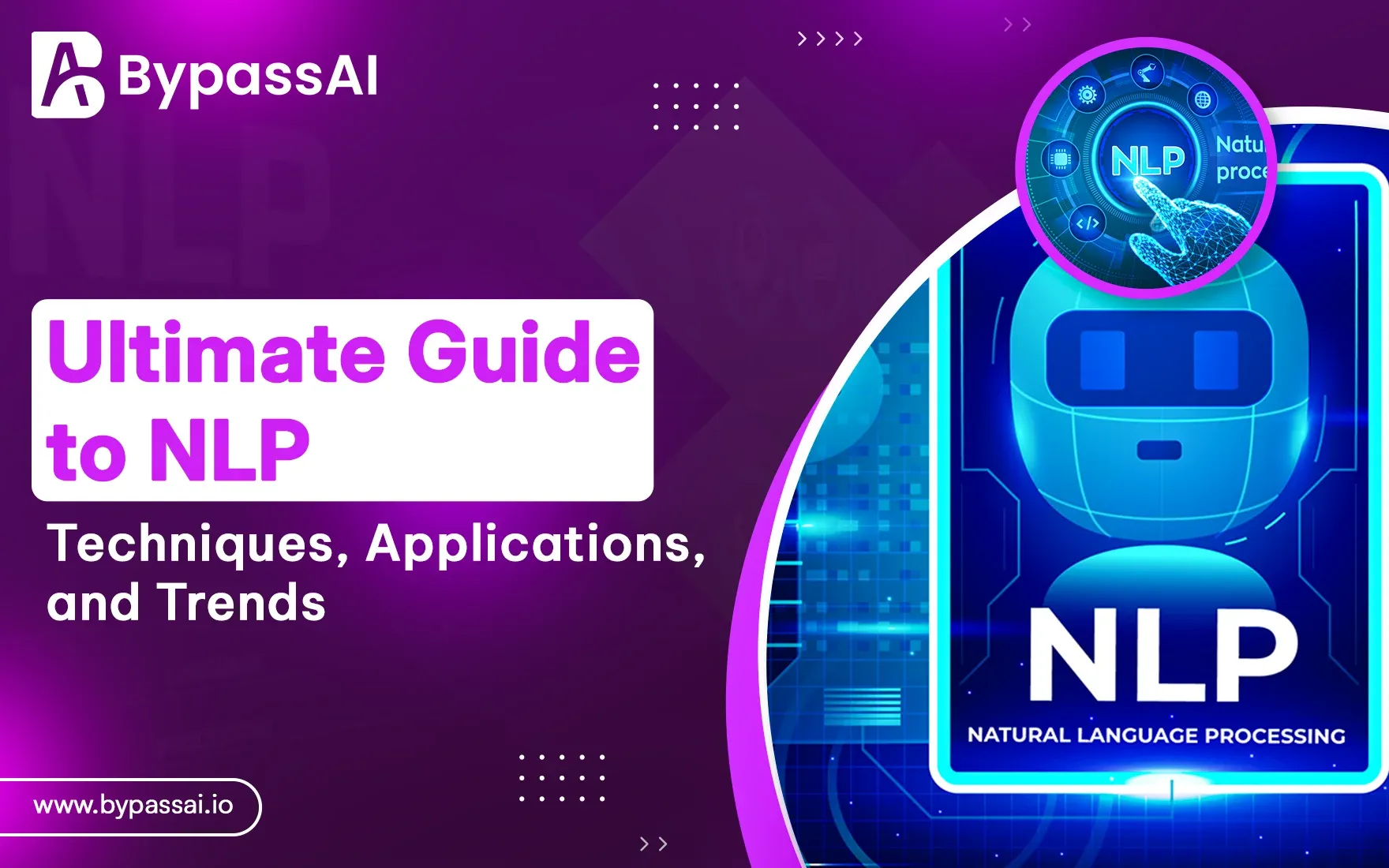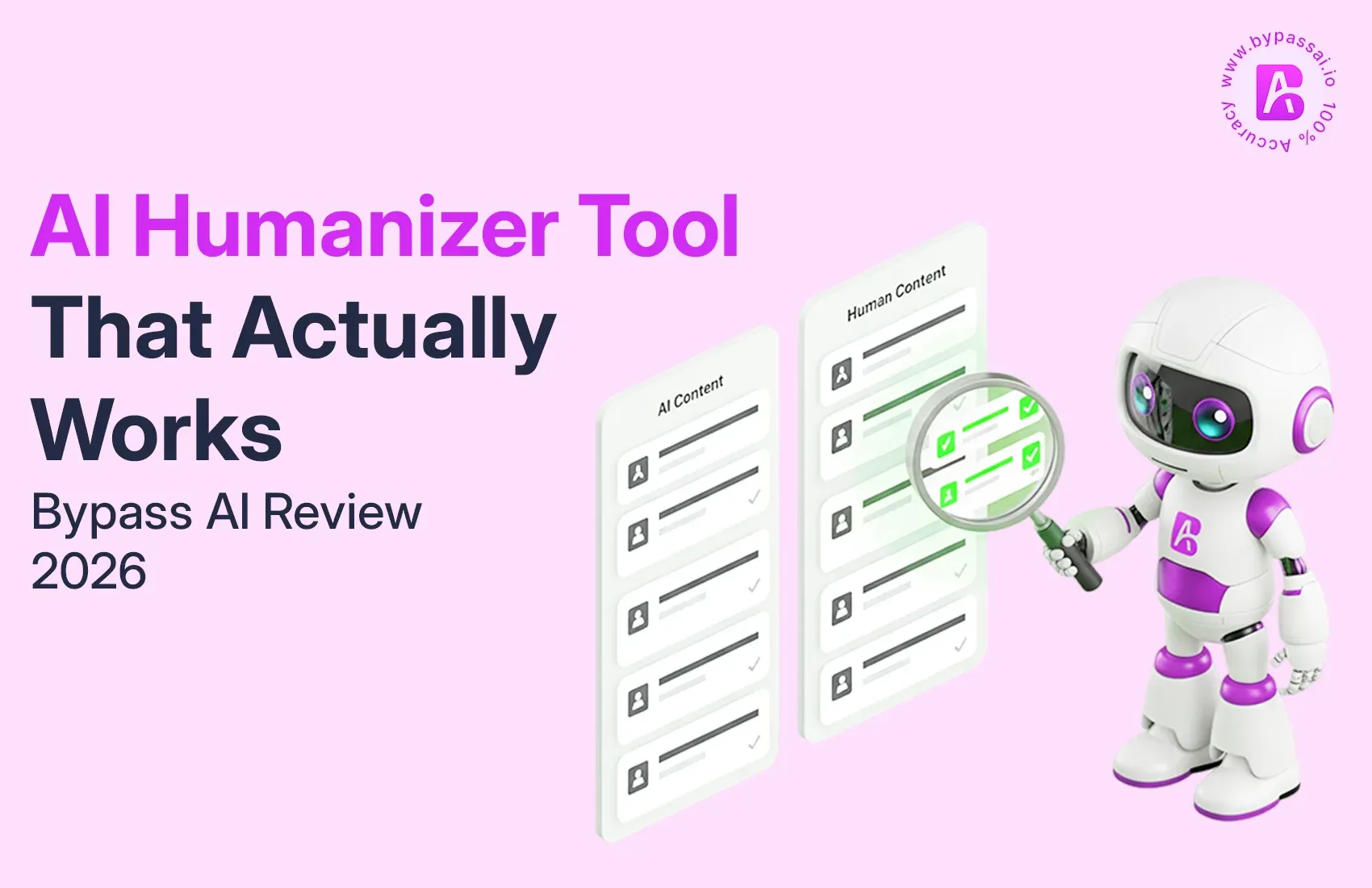Sign In
Welcome to Bypass AI! Sign in to continue your exploration of our platform with all its exciting features.
Forgot Password?
Don’t have an account ? Sign up
Sign Up
Embrace the Future with Bypass AI! Sign up now and let's rewrite the possibilities together.
You have an account ? Sign In
Enter OTP
We’ll send you an OTP on your registered email address
Back to Login
Forgot Password
We'll Send You An Email To Reset Your Password.
Back to Login
Enter OTP
We'll send you an email to reset your password.
Back to Login
Confirm Password
Please enter your new password.
TABLE OF CONTENTS
Quick Summary
What is Natural Language Processing?
How Does NLP Work?
Components of NLP
NLP Techniques and Methods
What is NLP Used For?
Open-source NLP Libraries
Challenges and The Future of NLP
Why Does Natural Language Processing (NLP) Matter?
Applications of Deep Learning in NLP
The Future of NLP
How to Get Started with NLP
Advantages of Natural Language Processing (NLP) across Industries
Natural Language Processing (NLP) Models
Conclusion
FAQs
When you converse with a Chatbot, you must have wondered how AI understands your language, and machines are able to understand human language because of NLP (Natural Language Processing). NLP has completely transformed how humans can interact with machines. Today, you will find Natural Language Processing (NLP) everywhere, be it Google Assistant, ChatGPT or Siri. The capabilities of machines to understand human language have become possible only because of NLP. According to many experts, the market value of ML and NLP will reach USD 453.3 billion by 2032, which is quite impressive.
But behind this NLP technology, there are quite broad processes and algorithms, due to which humans are able to talk naturally with machines.
And today, in this detailed article, we will understand Natural Language Processing from basics to an advanced level and will also know how it works and how it has helped in the development of Artificial Intelligence.
Quick Summary
Whatever models, agents or LLMs there are today, NLP has the biggest role behind their success, because if Artificial Intelligence does not have the capabilities of natural language processing, then it cannot understand the input of humans, nor can it give them output.
Natural Language Processing has many techniques and applications. Apart from this, there are many challenges in implementing NLP, but in the last 2 years, I have personally noticed that NLP is impacting many industries, and it is also making a very important contribution to the evolution of future models.
Our Focus in this article:
- What is Natural Language Processing, and how does it work?
- What are the important applications and techniques of Natural Language processing?
- What challenges can be faced by using NLP?
- What kind of impact is NLP having on the industry, and what is the future of NLP?
What is Natural Language Processing?
Natural Language Processing (NLP) is a field of artificial intelligence that helps computers and systems to understand, interpret and generate answers in the natural language of humans. Human language is quite messy compared to the structured numbers data available in a spreadsheet, which is full of slang, idioms, and cultural nuances. And NLP acts as a bridge between humans and machines, which gives them the capabilities to communicate with humans in their natural language.
If we understand NLP in simple terms, then it makes machines capable of many tasks like reading a document, answering someone's questions, translating a text and summarizing an article.
Historical Context
NLP is not a new concept; rather, it has been in the market ever since smart machines started being made. It first started in the 1950s as simple rule-based systems and machine translation experiments. With time, statistical models (like Hidden Markov Models) have further improved language analysis. And in the last decade, as deep learning and transformer-based models (like BERT and GPT) advanced, NLP also evolved to incredible levels and by 2025, NLP has become so capable that it can understand almost all the languages of the world and answer in that natural language.
NLP has transformed unstructured language into structured data so that communication can be established between humans and machines, just like humans communicate with other humans.
How Does NLP Work?
If you want to understand NLP, then you should simply understand how raw human language is transformed, which even computers can understand. Let's try to understand its working a little more deeply.
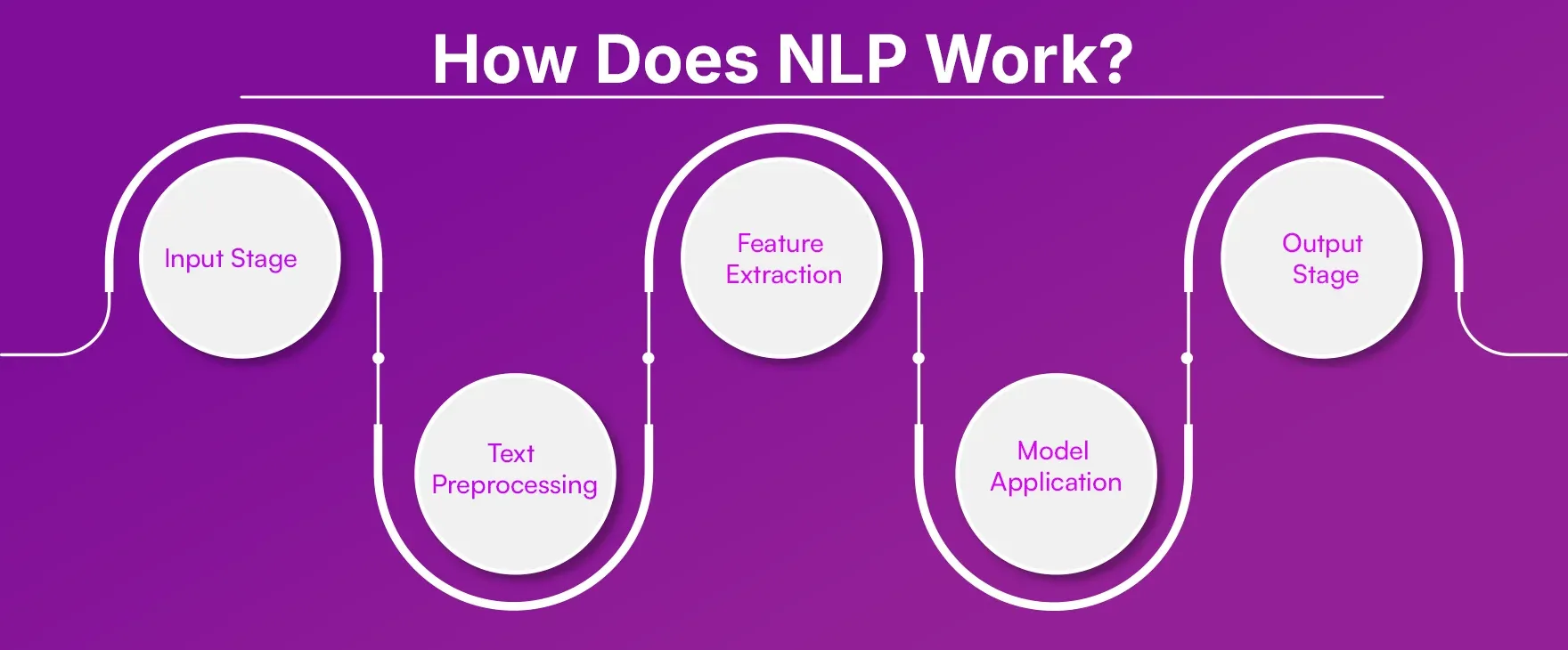
1. Input Stage: It starts with some raw text or speech. It can be your typed message or it can be a voice command that you use in a search engine, or it can be a document.
2. Text Preprocessing: As we know, the natural language of humans is quite messy, so after getting the input, NLP cleans it in preprocessing. In this, it follows many steps like tokenization (in which it splits the sentence into words), removing stop words (like “the” or “is”), and it also uses stemming/lemmatization (in which it tries to reduce the base form of the words)
3. Feature Extraction: As soon as it is cleaned, it converts the text into numerical form. Traditional methods used Bag of Words or TF-IDF, but modern systems rely on embeddings that can capture semantic meaning.
4. Model Application: Machine learning or deep learning models are applied here.
For example, a classification model can always predict whether a review is positive or negative, and the same translation model converts English to French.
5. Output Stage: And finally, the processed text is converted back into a usable form, be it a chatbot reply, a translated paragraph, or a summarized article.
The biggest capability of NLP is how smartly it makes human language understandable for machines and gives the final answer in human language, not machine language. It is because of NLP that today's models are able to handle context, nuance, and intent better.
Components of NLP
NLP is not a single process, but it uses a combination of multiple layers together to help machines understand human language.
1. Syntax Analysis: It deals with the structure of language. And it follows many processes, including tokenization (breaking down sentences into words), parsing (to understand grammatical structure) and part-of-speech tagging (to identify nouns, verbs, adjectives, etc.) Syntax helps machines to understand words together in the correct way.
2. Semantics: As we have understood, syntax focuses on structure, and semantics focuses on machines. It ensures that the machine understands words properly according to the context.
For example, If we are talking about water, then semantics helps the machine to understand that we are talking about the river "Bank" and not the financial "Bank".
3. Pragmatics: It largely depends on contextual understanding, and it is quite beyond literal meaning.
For example, if someone says "Can you open the window?" then the pragmatic interpreter interprets it as a request, not a yes/no question.
4. Discourse Processing: Human conversation consists of many sentences. Discourse tracks the flow of language through references, conversation history, and logical connections between multiple sentences.
All these components together make NLP capable enough to interpret raw human words in a meaningful way. So that humans can be brought closer to machines.
NLP Techniques and Methods
Over the past few years, NLP has evolved a lot, using a wide range of techniques and methods, from simple rule-based approaches to advanced neural networks. Let's take a look at some of the popular techniques and methods of NLP.

1. Text Preprocessing
The system ensures that the text is completely clean before analysis.
Tokenization: It splits sentences into words and subwords so that the machine can understand the input.
Stop word removal: The NLP system filters out common words that are uninformative, such as "is," "the," or "and."
Stemming and Lemmatization: It reduces words to their base and dictionary form.
Normalization: It handles spelling variations, lowercasing, and punctuation. It cleans up text.
2. Feature Extraction
Machines and software need numbers, not words. For this, NLP follows popular approaches which include:
Bag of Words (BoW): It analyzes the frequency of word counts.
TF-IDF (Term Frequency Inverse Document Frequency): It gives priority and importance to words that set the important tone of the input.
Word Embeddings: It uses Word2Vec, GloVe, or fastText techniques to capture semantic meaning. For this, it places words in a vector space.
3. Machine Learning Approaches
Traditional NLP used statistical models which followed Naïve Bayes, Logistic Regression models. These models were better for classification and tagging tasks but did not have any contextual awareness. But modern NLP uses machine or deep learning to enhance the context.
4. Rule-based vs. Statistical Methods
Earlier systems used handicrafted linguistic rules, including grammar-based parsing, and statistical methods have increased performance considerably.
5. Neural Network Techniques
Modern NLP follows deep learning models, particularly from the Koch Institute.
RNNs (Recurrent Neural Networks) and LSTMs are used for sequential text.
Transformers like (BERT, GPT, and T5) rely on attention mechanisms for context capture across large text spans.
All these advancements have made NLP more context-aware and scalable. And that is why NLP is used today in all chatbots, search engines, and AI assistants.
According to Chatbot magazine, businesses that have used NLP to automate predefined functions of their operations have been able to reduce customer support costs by 30%, and this is largely due to modern techniques of NLP.
What is NLP Used For?
Today, NLP is one of the most practical branches of Artificial Intelligence, which helps in communication between humans and machines on a daily basis.
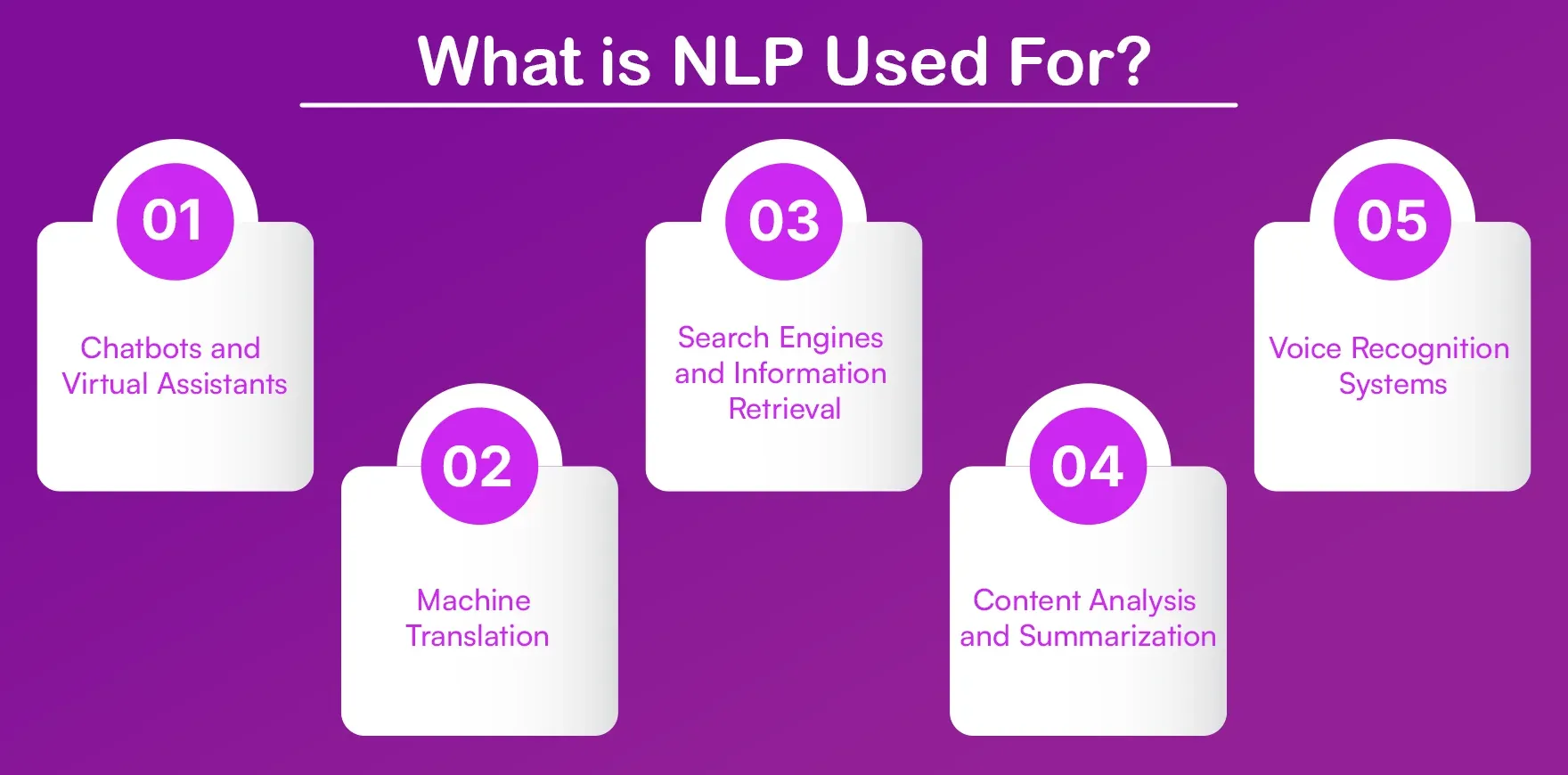
1. Chatbots and Virtual Assistants
From Siri, Alexa, to customer service chatbots, NLP is used everywhere so that machines can understand user queries and respond naturally accordingly. All these systems are context-dependent to maintain conversations on all platforms.
2. Machine Translation
Services like Google Translate use advanced NLP models to break the language barrier. Earlier translations were quite clunky, but thanks to transformer-based models, today these services are context-aware, which gives us fluent results.
3. Search Engines and Information Retrieval
When you type your query on Google, NLP uses its algorithms to interpret the intent of your input and not just literal keywords. This gives you relevant search results, autocomplete suggestions, and even voice search accuracy.
4. Content Analysis and Summarization
NLP can scan thousands of documents at a time and deliver a summary, that too in seconds. News outlets, researchers, and businesses use it to process information quickly.
5. Voice Recognition Systems
Voice assistants and transcription tools rely heavily on NLP to convert human speech into text and interpret its meaning accordingly
Example: YouTube, Netflix are the best examples of this, where you get to see the caption of the video in real time.
All these applications highlight that NLP is not only available in the research field but it is already used in all the technologies of our daily life, and it is further reshaping the communication between humans and machines.
Open-source NLP Libraries
One of the biggest reasons NLP is so advanced is the availability of powerful open-source libraries. These tools make it easy for developers, researchers, and even beginners to experiment with NLP.
1. Python Libraries
NLTK (Natural Language Toolkit): This is a classic library used for learning and experimentation. Tokenization, tagging, and parsing are very important in it.
spaCy: This processing model is known for its speed and efficiency, spaCy is mostly used for entity recognition.
Transformers (Hugging Face): This library has transformed NLP a lot, and for this it has used BERT, GPT, and T5 models. And it is accessible to everyone.
2. R Packages
R also offers packages like text2vec and tm, which are useful for text mining, feature extraction, and sentiment analysis and are popular for academic and statistical projects.
3. Java-based Tools
Libraries like Stanford CoreNLP provide a full suite of tools for NLP tasks, including operations like sentiment detection to named entity recognition, making it popular for large-scale applications.
Getting Started: Beginners start with NLTK for theory and experiments, then they move on to spaCy or Hugging Face so that they can do real-world projects. Its community support and documentation libraries make it highly beginner-friendly.
Challenges and The Future of NLP
NLP has been in use for several decades, but it still faces some serious challenges that limit its full potential.

1. Language Ambiguity
As we know, human language is inherently ambiguous. A single word can have multiple meanings depending on the context.
For example: "Crane" can be a bird or a construction machine. And sometimes even advanced models misinterpret in such cases
2. Cultural and Linguistic Diversity
Most NLP systems perform very well in English, and because of the high resources available in English, they struggle to understand low-resource languages, their words, and regional slang. This creates a digital divide in a way that the benefits of AI are not equal for all languages.
3. Bias and Ethics
Since NLP models are trained on internet-scale data, they also absorb the biases that are available on the internet. This creates stereotypical or unfair outputs in contexts such as hiring, law or healthcare. This creates a huge question mark on the ethical use of NLP.
4. Technical Limitations
Today, even powerful models like GPT require huge computing resources. This makes NLP quite expensive for smaller businesses. Sometimes these models also “hallucinate” facts, which raises trust issues.
Why Does Natural Language Processing (NLP) Matter?
NLP matters so much because it creates a bridge for communication between humans and machines; without it, computers can only understand structured commands, not the natural way of speaking, writing or texting.
1. Business Impact and ROI
Companies rely on NLP for chatbots, sentiment analysis, and automated customer service, and it reduces their operational cost and also improves response time.
Most banks also use NLP to detect fraud patterns in conversations, and the same e-commerce platforms use it to increase their sales and for personalized product recommendations.
2. Technological Advancement Driver
All the LLMs, AI Models, and Tools that we see today are largely possible due to NLP. And as NLP and AI models improve, they will not only increase the accuracy of search but will also help in knowledge discovery, translation, and decision-making in all industries.
3. Solving Real-world Problems
We get to see technologies inclusive of NLP, such as speech-to-text for accessibility, language translation for cross-border communication, and healthcare solutions that analyze patient records. All these features are solving real-world problems to a large extent for millions of people on a daily basis.
4. Competitive Advantage
Businesses are adopting NLP to give them a serious edge in their business so that they can make their workflows faster, enhance their customer engagement and create actionable insights from vast unstructured data.
NLP is so important in today's time because it is not a niche tool or AI, but it has become a strategic necessity for all AI models, agents. Due to this, businesses, researchers, and individuals are all using NLP in today's digital age.
Applications of Deep Learning in NLP
Deep learning has revolutionized NLP and enabled systems to produce more accurate, contextual, and human-like results. It uses statistical models rather than relying on handcrafted rules. NLP has greatly enhanced neural networks, which allow them to process massive amounts of text and capture subtle meanings.
1. Neural Networks in Language Processing
Models like RNNs (Recurrent Neural Networks) and LSTMs (Long Short-Term Memory networks) have greatly improved sequence modelling, which allows machines to understand the context of sentences. This was a huge transformation for the translation, sentiment analysis, and speech recognition industry and their tools.
2. Transformer Models and Attention Mechanisms
Transformers proved to be a huge technology changer by introducing a new concept called "Attention", in which instead of processing the text word by word, it tries to capture the complete sentence one at a time.
3. Breakthrough Models
BERT (Bidirectional Encoder Representations from Transformers): This model is quite expert in understanding context in both directions of a sentence.
GPT (Generative Pretrained Transformer): This model is an expert in generating new or human-like text.
T5 and XLNet: These models greatly enhance the performance of translation, summarization, and question answering.
4. Performance Improvements
Deep learning models perform better than traditional methods for all NLP tasks, whether it is chatbots, search engines, translation tools, or content summarizers tools. They also greatly support zero-shot and few-shot learning, which means they can easily perform new tasks with little or no training.
Deep learning has enabled NLP to advance from basic language handling to intelligent conversation systems, and is shaping how well humans can ultimately interact with AI.
The Future of NLP
The future of NLP looks quite full proof and promising, as it has evolved from simple text understanding to multimodal, which includes adaptive intelligence, which makes it even better.
1. Multimodal AI Integration
In the future, NLP systems will not only process text but will also be able to integrate with images, audio, and video.
Just imagine a medical AI that can easily read and analyze a patient's blood reports, X-rays, which will help a lot in diagnosis. USA healthcare giants like Mayo Clinic already use AI for disease diagnosis, and all this is possible only due to Multimodal AI integration.
2. Cross-language Capabilities
As NLP models evolve, these models will be able to support all languages of the world except English. There is a reason for creating different models for different languages. Such a unified system will be created that will be capable of handling thousands of queries in different languages, which will enable global communication to run effortlessly.
3. Industry-specific Adaptations
In the next few years, you can expect to see NLP models for all specific domains, be it healthcare, finance, legal, and education sectors. These models will be able to understand all industry requirements, compliance rules, and specialized workflows, which will make them more useful for real-world scenarios.
4. Next-generation Breakthroughs
NLP will start using self-supervised learning, federated learning, and quantum computing in the next few years, which will further enhance the speed, accuracy, and accessibility of NLP. And by 2030, NLP will become a context-aware personal AI agent that will be able to reason, plan, and collaborate with humans.
In the future, NLP will not only understand words but will also understand the intent, emotion, and nuance of the input, which will come much closer to human understanding.
How to Get Started with NLP
If you are new to NLP, this journey may seem frustrating, but if you follow the right steps, you will be able to enhance your skills quickly.

1. Learn the Basics
Start with your core programming skills. Python is the most popular language for NLP, and its simple syntax and rich ecosystem libraries like NLTK, spaCy, and Transformers make it even better. Try to gain a basic understanding of the data structures, loops, and functions that are needed.
2. Study NLP Fundamentals
After this, familiarize yourself with tokenization, stemming, lemmatization, and embedding processes. For this, you can use tutorials, blogs, and YouTube channels, and these are a good option to get started. And for structured learning, you can prefer courses from Coursera or DataCamp, or edX.
3. Hands-on Practice
Start with small projects like doing sentiment analysis of tweets, building a spam classifier, or creating a chatbot that follows basic NLP rules. When you work on real datasets, your problem-solving skills will improve.
4. Move to Advanced Tools
Once you are comfortable, you can explore transformer models through Hugging Face’s Transformers library. And experiment with pre-trained models like BERT or GPT to understand modern NLP applications.
5. Join Communities
After this, participate in different NLP forums and groups like Kaggle, GitHub, and Reddit’s NLP groups. There, you can share your work and gain knowledge from others’ work and discuss any doubts in related groups, which will make your growth very fast.
When you practice and learn with consistency, you will be capable of creating real-world NLP projects in the next few months.
Advantages of Natural Language Processing (NLP) across Industries
NLP is not a research concept today. Rather, it is bringing about a huge transformation in real-world industries. NLP is giving machines the power to understand the natural language of humans. Overall, NLP has increased efficiency, personalization, and better decision-making capabilities.
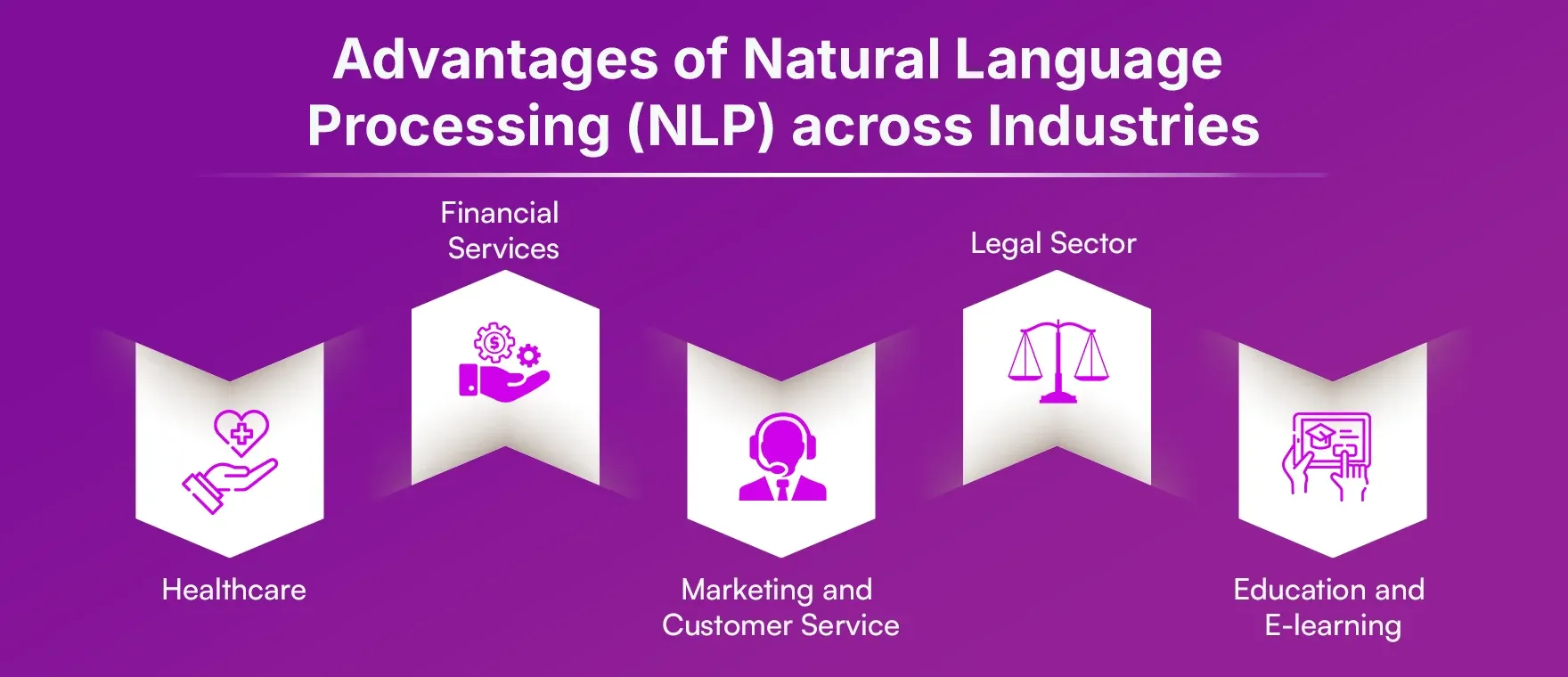
1. Healthcare
Many doctors and hospitals use NLP to analyze patient records and extract medical information, and are even capable of predicting health risks. Due to the AI model, virtual assistants also take care of patients by giving medication reminders or checking symptoms.
2. Financial Services
Banks and Fintech companies use NLP for fraud detection, automated customer support, and market sentiment analysis. This helps them make faster, data-driven investment and lending decisions.
3. Marketing and Customer Service
NLP helps businesses deliver personalized experiences by analyzing customer conversations, feedback, and behaviour. Chatbots can handle 24/7 support tickets, which helps brands maintain customer trust.
4. Legal Sector
Many law firms use NLP to review lengthy contracts, flag compliance risks, and summarize documents, saving time and reducing errors in legal research. This saves them a lot of time.
5. Education and E-learning
NLP has revolutionized the educational sector by making personalized smart tutoring possible, giving students personalized learning paths. It also analyzes student feedback to improve the teaching strategies of its platform or model.
NLP gives businesses a competitive edge across all industries by converting unstructured text into actionable insights that allow organizations to work smarter, not harder.
Natural Language Processing (NLP) Models
Natural Language NLP models are the core engines that transform raw language into structured data that is readable by machines. Over time, these models have evolved from simple statistical approaches towards deep learning architectures.
1. Traditional Statistical Models
Earlier NLP models relied heavily on Naïve Bayes, Hidden Markov Models (HMMs), and Conditional Random Fields (CRFs). These models were quite good for tasks like part-of-speech tagging and named entity recognition, but they struggled with deep context and long sequences.
2. Neural Network Architectures
As deep learning rose, NLP shifted towards RNNs (Recurrent Neural Networks), LSTMs (Long Short-Term Memory networks), and GRUs (Gated Recurrent Units). These models enhance context handling even more, but still struggle with long sequences.
3. Transformer-based Models
NLP evolved mostly from the introduction of transformers, which use attention mechanisms to capture context across text. Currently, BERT, GPT, RoBERTa, and T5 are the most popular transformer models. These are great for chatbots, translation systems, and summarizers.
4. Pre-trained vs. Custom Models
Pre-trained models (like GPT or BERT) are trained on huge datasets that are fine-tuned for specific tasks.
Custom models are built from scratch for domain-specific needs, like medical or legal NLP.
Choosing the right model depends largely on the available task and computational resources.
Conclusion
Natural Language Processing (NLP) evolved from simple rule-based systems to transformer-powered AI models that can understand human language and generate human-like text that humans can understand. Today, it is the backbone of chatbots, translation engines, search systems, and countless AI-powered tools we use in our daily lives.
For businesses, NLP provides a competitive advantage by enhancing unstructured texts, enhancing customer experience, and automating many complex tasks. And for individuals, it makes technology more accessible and simple.
So, whether you are a student, a writer or a developer, Natural Language Processing is making a huge impact on everyone's life, and if you need help in any of your copywriting-related tasks, then you can use BypassAi.io, this is a much better platform for copywriting, where you will get multiple tools in a single platform.
FAQs
1. What is NLP, and what is it used for?
NLP (Natural Language Processing) is a branch of AI that helps computers understand, interpret, and generate human language. Be it chatbots, AI agents, translation tools, search engines, voice assistants, or text analysis applications, all use natural language processing.
2. What are the 4 types of NLP?
There are many types of NLP, but there are 4 main types: Syntax Analysis, Semantics, Pragmatics, Discourse.
3. Is NLP a programming language?
No, NLP is not a programming language, but it is a field of Artificial Intelligence. But still, it is deployed using libraries and frameworks through Python, R, or Java.
4. What is the difference between NLP and LLM?
NLP is a much broader field of AI, whose focus is to process, understand human language and generate answers accordingly. And LLMs (Large Language Models) like GPT or BERT are a type of specific AI model which are trained using different datasets, and these Chatbots are used for different answers, content or research purposes, but LLMs also have to use NLP to understand human language.
5. What is NLP in AI?
NLP is a type of AI, as you can understand, a technology that creates a bridge of understanding between humans and machines, due to which communication becomes easy. And it helps Chatbots or models to understand the natural language of humans in a conversational way.

